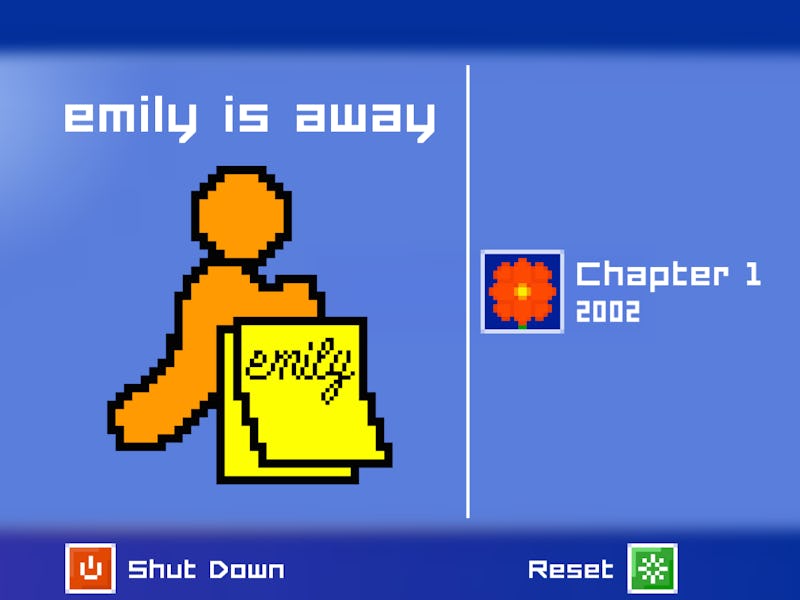An Appreciation of 'Emily Is Away', a Game Based in AIM Chat and Millennial Nostalgia
'Emily is Away' creator Kyle Seeley says AOL instant messenger was an "interface ripe with emotional tension."

Developer Kyle Seeley originally entered his text focus game, Emily is Away, into the Interactive Fiction Competition 2015 earlier this year, only to withdraw the project for public release in October. The game, or digital interactive novel, allows players to chat with a character named Emily several times.
“The early 2000’s were a time before Facebook, YouTube, and texting” says Seeley over e-mail. “All we had to communicate was AIM, and as a result, I had some of the most formative conversations of my life over that medium. Plus it’s an interface ripe with emotional tension — the anticipation in waiting for a response, the stress of crafting your own message, or just waiting for that special someone to come online.”
He’s right, of course. His game actually recreates AIM’s unique angst. Even if the player chooses to respond to Emily a certain way, the game sometimes deletes the original, honest input — “I have feelings for you” or something similar — replacing it, dramatically, with a more protective, neutral statement.
The culture of AOL instant messaging has been rendered with painstaking detail in the game. Emily’s profile, as well as the profiles of other users on the player’s buddy list, is viewable. Each new chat allows the player to choose a new buddy icon, and the options range from cartoon animals to bands that were popular in the early 2000s.
It is clear when playing, just as it was when we were all teenagers chatting on AIM, that every minute decision made online matters a great deal to our peers. When the player expresses an opinion to Emily on current music — she likes Coldplay and Snow Patrol — a message appears quickly and fades away: “Emily will remember this…”
“I think it’s just a really relatable story,” Seeley added. “Most of us have a childhood friend that we ended up growing apart from. Players end up projecting their own memories/experiences onto the characters in the game. I think a lot of the fun comes from seeing the different paths that our own lives could have gone down.”
Since its release, Emily is Away has been reviewed positively by Kotaku and Wired. It was featured by Indiecade Digital, the Boston Festival of Indie Games and the Indie Dev Super Show. Aside from being critically adored, Emily is Away has also inspired a large player base in just several months. Though I heard about the game as a Bostonite — Kyle Seeley is from Boston himself — my kid brother in New Mexico knew about the game only weeks after I did, because a YouTuber named SSundee had reviewed the game for his 5.5 million followers, one of which being my brother.
My brother, who was born in 2003, wouldn’t fully understand Emily is Away, which is the game’s most beautiful aspect. It recalls a very specific period in time, one that mattered very much to a small group of millennials. AIM, the service that those of us who were teenagers in the early 2000s used every day after school, died out seemingly as quickly as it appeared.
Emily is Away capitalizes on the nostalgia of gamers now in their twenties and pays homage to a technology now outdated, though it was only released in 1997. This enterprise, casting a nostalgic sheen on technology that users even one or two generations back wouldn’t recognize, is an inherently millennial one. As games like Seeley’s Emily is Away continue to be released, we will see the formation of a canon of meta-textual millennial commentary. Seeley’s game is a digital novel, a millennial form of storytelling in itself, and it comments on yet another form of storytelling by engrossing the player in a headspace that was once very familiar: checking to see if a particular person on one’s buddy list is online, and wondering what to say to them.
Several cultural critics have said millennials collectively have “early on-set nostalgia”, but Seeley’s game explains this phenomenon deftly. We are a generation defined by the rapid expansion and development of social and communication technology, so our quick turnaround with feelings of nostalgia is simply a response to our changing digital landscape.
“Evoking nostalgia is really important to correctly convey the story,” Seeley says. “It’s my hope that the nostalgia will transport players back into their own memories, inviting them to project their own experiences onto the story. That way they can explore the game’s narrative while also thinking critically about their own past.” With the help of uncannily realistic-feeling games like Emily is Away, we’ll be able to do just that: reflect on who we were just years ago, and analyze what mattered to us when we communicated with peers.
Emily is Away is available for free (or pay as you wish) on Steam and Itch.io.